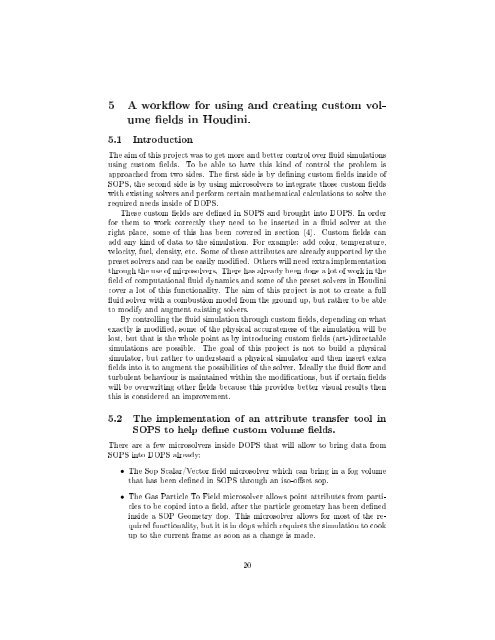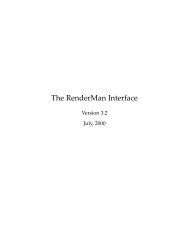Controlling Fluid Simulations with Custom Fields in Houdini Master ...
Controlling Fluid Simulations with Custom Fields in Houdini Master ...
Controlling Fluid Simulations with Custom Fields in Houdini Master ...
You also want an ePaper? Increase the reach of your titles
YUMPU automatically turns print PDFs into web optimized ePapers that Google loves.
5 A workow for us<strong>in</strong>g and creat<strong>in</strong>g custom volumeelds <strong>in</strong> Houd<strong>in</strong>i.5.1 IntroductionThe aim of this project was to get more and better control over uid simulationsus<strong>in</strong>g custom elds. To be able to have this k<strong>in</strong>d of control the problem isapproached from two sides. The rst side is by den<strong>in</strong>g custom elds <strong>in</strong>side ofSOPS, the second side is by us<strong>in</strong>g microsolvers to <strong>in</strong>tegrate those custom elds<strong>with</strong> exist<strong>in</strong>g solvers and perform certa<strong>in</strong> mathematical calculations to solve therequired needs <strong>in</strong>side of DOPS.These custom elds are dened <strong>in</strong> SOPS and brought <strong>in</strong>to DOPS. In orderfor them to work correctly they need to be <strong>in</strong>serted <strong>in</strong> a uid solver at theright place, some of this has been covered <strong>in</strong> section (4). <strong>Custom</strong> elds canadd any k<strong>in</strong>d of data to the simulation. For example: add color, temperature,velocity, fuel, density, etc. Some of these attributes are already supported by thepreset solvers and can be easily modied. Others will need extra implementationthrough the use of microsolvers. There has already been done a lot of work <strong>in</strong> theeld of computational uid dynamics and some of the preset solvers <strong>in</strong> Houd<strong>in</strong>icover a lot of this functionality. The aim of this project is not to create a fulluid solver <strong>with</strong> a combustion model from the ground up, but rather to be ableto modify and augment exist<strong>in</strong>g solvers.By controll<strong>in</strong>g the uid simulation through custom elds, depend<strong>in</strong>g on whatexactly is modied, some of the physical accurateness of the simulation will belost, but that is the whole po<strong>in</strong>t as by <strong>in</strong>troduc<strong>in</strong>g custom elds (art-)directablesimulations are possible. The goal of this project is not to build a physicalsimulator, but rather to understand a physical simulator and then <strong>in</strong>sert extraelds <strong>in</strong>to it to augment the possibilities of the solver. Ideally the uid ow andturbulent behaviour is ma<strong>in</strong>ta<strong>in</strong>ed <strong>with</strong><strong>in</strong> the modications, but if certa<strong>in</strong> eldswill be overwrit<strong>in</strong>g other elds because this provides better visual results thenthis is considered an improvement.5.2 The implementation of an attribute transfer tool <strong>in</strong>SOPS to help dene custom volume elds.There are a few microsolvers <strong>in</strong>side DOPS that will allow to br<strong>in</strong>g data fromSOPS <strong>in</strong>to DOPS already:• The Sop Scalar/Vector eld microsolver which can br<strong>in</strong>g <strong>in</strong> a fog volumethat has been dened <strong>in</strong> SOPS through an iso-oset sop.• The Gas Particle To Field microsolver allows po<strong>in</strong>t attributes from particlesto be copied <strong>in</strong>to a eld, after the particle geometry has been dened<strong>in</strong>side a SOP Geometry dop. This microsolver allows for most of the requiredfunctionality, but it is <strong>in</strong> dops which requires the simulation to cookup to the current frame as soon as a change is made.20















